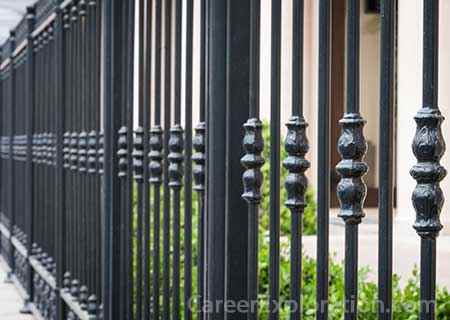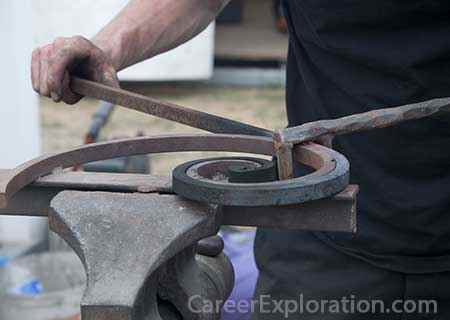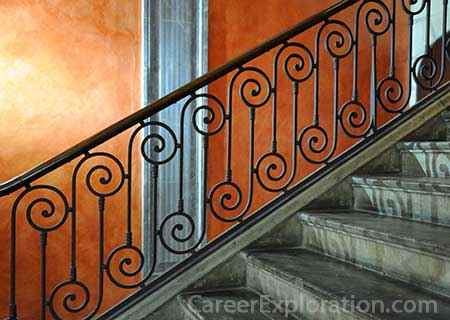
Ironworkers install structural and reinforcing iron and steel to form and support buildings, bridges, and roads.
What Do Ornamental Iron Workers Do?
Duties
Ironworkers typically do the following:
- Read and follow blueprints, sketches, and other instructions
- Unload and stack prefabricated iron and steel so that it can be lifted with slings
- Signal crane operators who lift and position structural and reinforcing iron and steel
- Use shears, rod-bending machines, and welding equipment to cut, bend, and weld the structural and reinforcing iron and steel
- Align structural and reinforcing iron and steel vertically and horizontally, using tag lines, plumb bobs, lasers, and levels
- Connect iron and steel with bolts, wire, or welds
Structural and reinforcing iron and steel are important components of buildings, bridges, roads, and other structures. Even though the primary metal involved in this work is steel, workers often are known as ironworkers or erectors. Most of the work involves erecting new structures, but some ironworkers may also help in the demolition, decommissioning, and rehabilitation of older buildings and bridges.
When building tall structures such as skyscrapers, structural iron and steel workers erect steel frames and assemble the cranes and derricks that move materials and equipment around the construction site. Workers connect precut steel columns, beams, and girders, using tools like shears, torches, welding equipment, and hand tools. A few ironworkers install precast walls or work with wood or composite materials.
Reinforcing iron and rebar workers use one of three different materials to support concrete:
- Reinforcing steel (rebar) is used to strengthen the concrete that forms highways, buildings, bridges, and other structures. These workers are sometimes called rod busters, in reference to rods of rebar.
- Cables are used to reinforce concrete by pre- or post-tensioning. These techniques allow designers to create larger open areas in a building because supports can be placed farther apart. As a result, pre- and post-tensioning are commonly used to construct arenas, concrete bridges, and parking garages.
- Welded wire reinforcing (WWR) is also used to strengthen concrete. This reinforcing is made up of narrow-diameter rods or wire welded into a grid.
Structural metal fabricators and fitters manufacture metal products in shops, usually located away from construction sites.
Career Snapshot
If you are an Ornamental Iron Worker you likely install prefabricated ornamental ironwork, other than structural ironwork, like metal window and door frames, motor-driven and automatic power doors, metal trim paneling, and aluminum curtain-wall frames. A variety of materials are used, for example, aluminum, steel, bronze and composites. Materials are fastened to structures by bolting or welding. Ornamental ironworkers are commonly referred to as "finishers” and are employed in construction of large commercial, industrial, and residential buildings.
(Workers in this construction sub-sector may also have the title of: Metal Trim Erector, Ornamental Bronze Worker, Ornamental Iron Erector, Ornamental Rail Installer, Steel Door Setter, Steel Sash Erector)
Job Details
Ornamental Iron Workers do the following:
- Install metal windows into a building's masonry or wooden openings.
- Erect curtain wall and window wall systems that cover the steel or reinforced concrete structure of a building.
- Install and erect metal stairways, catwalks, gratings, doors, railings, fencing, elevator fronts and building entrances.
- Communicated with fabricators and designers to create final product
- Measures and marks layout for installation
- Drills holes in metal, concrete, and also masonry structure using mag drill, hammer drill, and hand tools
Education and Experience
A high school diploma or equivalent is typically required to enter the occupation. Most ornamental iron workers need an apprenticeship; ideally, a schedule that provides equal training in structural, reinforcing, ornamental, welding and rigging. Such an apprenticeship typically lasts 3-4 years.
Career Outlook
- Salary: An entry level ornamental iron worker (1-3 years of experience) earns an average salary of approximately $39,000. A senior level ornamental iron worker (8+ years of experience) earns an average salary of approximately $65,000.
- Employment growth forecast 2018-2028:
- Entry-level education: High school diploma, G.E.D., or equivalent
Career Growth Opportunity
Growth for ornamental iron workers is expected to be faster than the average for all capacities through 2020.
Professional Associations
- International Association of Bridge, Structural, Ornamental and Reinforcing Iron Workers - The IW represents 120,000 members in North America. Members of this union have worked on nearly every major construction project you can think of - the Golden Gate Bridge, the Sears Tower, the St. Louis Arch, the Oil Sands Plant Expansion in Alberta, the World Trade Center and Freedom Tower. IW represents ironworkers who work on bridges, structural steel, ornamental, architectural, and miscellaneous metals, rebar and in shops.
- National Center for Construction Education and Research - NCCER is a non-profit education foundation. It was developed with the support of more than 125 construction CEOs and various association and academic leaders who united to revolutionize training for the construction industry. Sharing the common goal of developing a safe and productive workforce, these companies created a standardized training and credentialing program for the industry.
- National Ornamental and Miscellaneous Metals Association - This organization has as its mission to serve its members and advances the metalworking industry through education and the promotion of a positive business environment.
- Association for Iron and Steel Technology - This non-profit has as its mission to advance the technical development, production, processing and application of iron and steel.
- Metal Museum - The Metal Museum is an institution that provides resources to those in metalwork. These resources are provided through exhibitions, internships, classes and more.
- National Institute of Steel Detailing - NISD’s mission is to foster a professional approach to business, by advocating improved quality, through member networking, education and certification, and create a better understanding of the importance of detailing services in the construction process.
- The Associated General Contractors of America - The AGC of America works to ensure the continued success of the commercial construction industry by advocating for federal, state and local measures that support the industry; providing opportunities for firms to learn about ways to become more accomplished; and connecting them with the resources and individuals they need to be successful businesses and corporate citizens.
- Associated Builders and Contractors, Inc. - ABC's mission is the advancement of the merit shop construction philosophy, which encourages open competition and a free enterprise approach that awards contracts based solely on merit, regardless of labor affiliation.
- American Welding Society - This organization is a non-profit with a global mission to advance the science, technology and application of welding and allied joining and cutting processes, including brazing, soldering and thermal spraying.
- Sisters in the Brotherhood - Sisters in the Brotherhood is a group dedicated to strengthening the UBC by promoting activism and diversity and by increasing the number of women members.
- Associated Builders and Contractors - ABC's mission is the advancement of the merit shop construction philosophy, which encourages open competition and a free enterprise approach that awards contracts based solely on merit, regardless of labor affiliation.
- Home Builders Institute - This organization’s mission is to advance and provide education, career development, training and placement of men and women serving the building industry.
- The Associated General Contractors of America - The AGC of America works to ensure the continued success of the commercial construction industry by advocating for federal, state and local measures that support the industry; providing opportunities for firms to learn about ways to become more accomplished; and connecting them with the resources and individuals they need to be successful businesses and corporate citizens.
- National Association of the Remodeling Industry - NARI connects homeowners with its professional members and provides tips and tricks so that consumers have a positive remodeling experience with a professional, qualified remodeler.
- National Association of Architectural Metal Manufacturers - In addition to published resources, NAAMM promotes it members and their products, provides forums for exchanging valuable technical information and specifications for building design professionals.
- Construction Specifications Institute – This is a national association of more than 8,000 experts in building construction and the materials used therein.
Publications
- Ironworker Magazine - Since its inception in 1901, The Ironworker has served as primary communication tool for our members, local union, district councils, and officers to keep apprised of ironworkers' interests locally and across North America.
- Constructor - online digital magazine
- Traditional Building Magazine - A magazine used by professionals for technical resources, design trends and information on historical preservation.
- Metal Working World Magazine - machine tools, sheet metal, technologies, news...
Credential Associations
- The Iron Workers Directory of Training Centers - A list of Iron Worker training centers and contact information throughout the United States and Canada, sorted by state or province.
- Ironworkers Apprenticeship and Training Department - The mission of this organization is to ensure that our union ironworkers have the skills, knowledge, and training necessary to be safe on the jobsite, competitive in the workplace, and satisfied in their careers.



